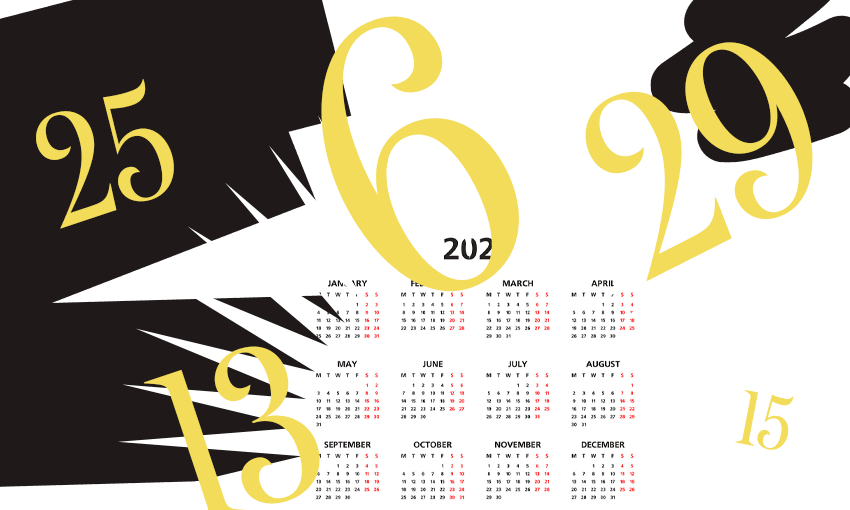Traffic lights, internal and external borders, hairdressers – there’s a lot to process. Here are the key dates for Aotearoa’s opening up, in one place.
Thursday November 25, 2021
Hairdressers in Auckland can reopen, but only to the fully vaccinated. This has been brought forward to trial the new My Vaccine Pass scheme which will be integral to the imminent traffic light framework. It is also a response to the clamour from hair salon operators and the sight of human hair bursting from the scalp and out bedroom windows like moth weed, smothering native flora and puppies. Good luck getting an appointment. No walk-ins.
Monday November 29
This was to be the day on which Cabinet would determine when parts or all of the country would go into the traffic light system, but that’s now already decided: December 3. They will still decide and announce on the 29th, however, which parts of the country go into which setting (though we already know a bit of that, see below).
Wednesday November 31
Borders will be open for the day, with no requirement to isolate, for nihilists only.
Friday December 3
RIP alert levels – hello traffic lights. The new “Covid-19 protection framework” arrives for the whole country (or 11.59pm on December 2 for the pedants) after some slapdash law-making. For a primer on the traffic light system, read this.
Announcements on the shade of traffic light for each area will have been announced at the start of the week. We do know already, however, that for Auckland red means go: that’s where the city will enter the system. It’s been made clear, too, that no part of the country will go directly to green. So, much like a Rothko canvas or the last American president, it will be a patchwork of orange and red.
(If you do want to hold a funeral for the alert level system at traffic light red, up to 100 can attend if you’re using vaccination certificates; up to 10 if you’re not.)
Wednesday December 15
The portcullises will lift (11.59pm on December 14 for the desperate pedants) around the muggy conurbation of Auckland, clearing the way for travel in and out of New Zealand’s biggest city. There are conditions, however: you need to provide evidence of full vaccination via the MVP or show that you’ve received a negative Covid test in the last 72 hours. You’ll be checked at the airport if you’re flying, and “spot checks” will be undertaken by police on the roads.
Saturday December 25
An annual festival commemorating the birth of Jesus Christ, who did not respond to requests for comment.
Saturday January 15, 2022
Unruly Tourist Day is held, marking the third anniversary of the moment a sunburnt, slightly pissed New Zealand suddenly became full-noise obsessed with a gaggle of British visitors leaving a trail of destruction rudeness and minor criminality around the country. Those were the days.
Monday January 17, 2022
Today marks the end of MIQ for fully vaccinated New Zealanders travelling from Australia. (Or 11.59pm on January 16 if you’re both pedantic and able to persuade an airline to schedule a flight for that hour.) Citizens, residents and their family members (more precisely: “other travellers eligible under our current border settings to travel directly into New Zealand”) will still need to isolate at home for seven days, as well as proving full vaccination, declaring their travel history (including not having been outside NZ or Australia over the previous 14 days), and providing a negative pre-departure test. Tests will also need to be returned negative after day zero or one and at the end of their week-long isolation.
This is the first in a three-step “medium risk pathway” that sees home-isolation increasingly become the norm for arrivals. The isolation requirements are unlikely to be as prohibitive as in the pilot scheme currently under way, given that Covid is now in the community. Chris Hipkins yesterday: “Further details on how self-isolation will be implemented will be made available in December, and include guidance on how people can travel from their arrival airport to their location of self-isolation and requirements for the places where they can self-isolate.”
Wednesday February 2
Most schools return today, though many start a few days earlier and some later; for the love of God don’t take our word for it. Under the traffic light framework, schools are open at every stage.
Monday February 14
Today is Valentine’s Day and it’s – look, I’m really sorry about this – coming up roses for fully vaccinated New Zealanders from just about anywhere who are double vaccinated, who can now skip MIQ. If you hate Valentine’s Day and you’re a pedant, you could try to sort out arriving at 11.59pm on February 13. The pre-departure and arrival testing remains, as above.
The only exception is people arriving from very high risk countries. With that classification lifting for Indonesia, Fiji, India, Pakistan and Brazil in early December 2021, that will leave just Papua New Guinea.
Sunday April 3
The final of the Women’s Cricket World Cup at Hagley Park in Christchurch.
Saturday April 30
Why a Saturday? Why no 11.59pm setting to confuse readers and delight pedants? No idea. But this is when New Zealand will open to fully vaccinated foreign nationals. More details on this will follow in the new year, including whether it might be staged according to visa status, and what the isolation requirements will be.
By then it will be more than two years since New Zealand’s borders were closed, you’ll be older (unless you’re reading this at some point in the future), and we’ll be heading into another winter.

